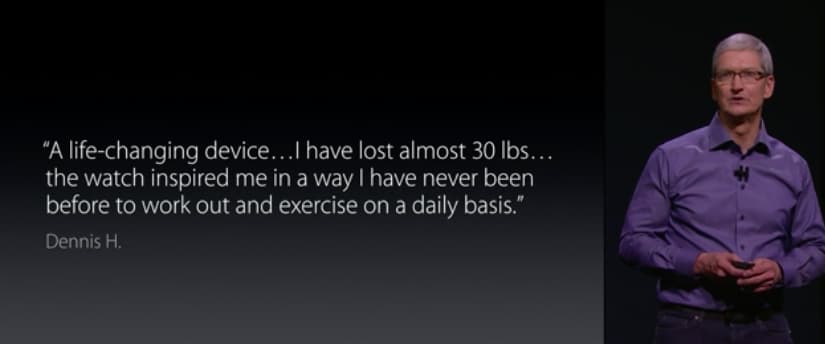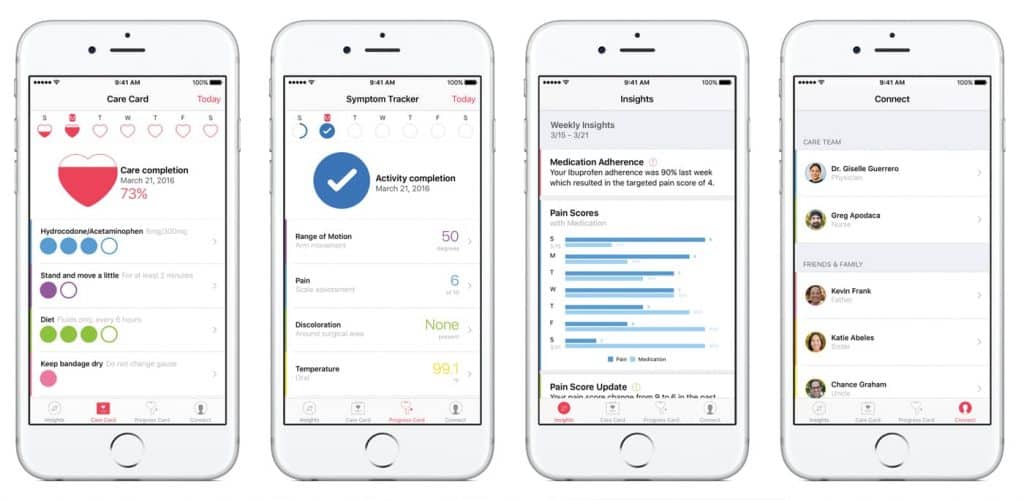Apple has been on a mission of improving healthcare from past few years. The company has hired top scientists and has partnered with leading hospitals to change the face of the healthcare business.
Apple’s ambitions about changing healthcare became clearer when it announced Apple Watch and the ResearchKit.
From helping doctors track their patients and prioritize their schedules to monitoring patient vitals through the Watch, Apple demonstrated it all.
Before we get onto the detailing of the Apple CareKit, let’s take a look at the landscape that Apple has paved for itself in the healthcare space.

The world noticed Apple Watch’s potential to help improve health care when it made people stand up every hour by tapping on the wrist.
Apple CEO Tim Cook has even called sitting “the new cancer.”

Not just that, Apple designed new software platforms like HealthKit and ResearchKit, intended to turn into a central repository for clinical data and clinical trials, respectively.
Meanwhile, Apple also struck deals with some of the leading health systems and have worked out arrangements with the nation’s leading provider of electronic health records to feed Apple HealthKit data directly into patients’ charts.
But now, Apple wants YOU to care about your health.
Enters Apple CareKit!
Last month, Apple announced CareKit, a new software framework designed to help developers enable people to actively manage their own medical conditions.
Apple hints on why CareKit can be a game changer for healthcare industry:
“Apps created with ResearchKit are already producing medical insights and discoveries at a pace and scale never seen before. That success has inspired us to widen the scope from medical research to personal care with the introduction of CareKit.”
Broadly speaking, CareKit is a framework for developers to build apps that let users manage their own well-being on a daily basis.

This video from Apple, demonstrates what ResearchKit has achieved and predicts what CareKit is capable of:
CareKit will be available to developers worldwide starting in spring 2016.
But before we go into exploring the opportunities let’s understand CareKit’s modules.
App feature suggestions for Apple’s CareKit:
Apple CareKit has 4 major modules and we have worked out the features you can build along with each module. Take a look:

#1 Care Card – This helps people track their individual care plans and action items, such as taking medication or completing physical therapy exercises. Activities can automatically be tracked and entered using sensors in Apple Watch or iPhone.
Suggested feature: This can be used to record information of patients medication and activities information.
#2 Symptom and Measurement Tracker – Lets users easily record their symptoms and how they’re feeling, like monitoring temperature for possible infections or measuring pain or fatigue. Progress updates could include simple surveys, photos that capture the progression of a wound or activities calculated by using the iPhone’s accelerometer and gyroscope, like quantifying range of motion.
Suggested feature: Can be used to record information of patients vital stats, symptoms, pain, fatigue, photos, range of information etc.
#3 Insight Dashboard – Maps symptoms against the action items in the Care Card to easily show how treatments are working.
Suggested feature: Can be used to chart the development of recorded information and can tell how well a treatment is working.
#4 Connect: Makes it easy for people to share information and communicate with doctors, care teams or family members about their health and any change in condition via integration with a custom developed telemedicine application.
Suggested feature: Share data between patients, medical providers, and family & friends. Corresponds to ‘Ecosystem’ and ‘Private Messages’ features.
4 use cases for Apple’s CareKit
Once again, Apple has thrown an open challenge for the app developers to experiment and innovate with its latest SDK, Apple CareKit.
“We’ve made ResearchKit and CareKit open source because we want everyone to be able to contribute to medical research and benefit from improved personal care. Open source frameworks are the best way to encourage the medical community and developers to collaborate and share their apps and methods. And we can’t wait to see what they do.”
Keeping you ahead of time, we have chalked out 4 opportunities your healthcare app can leverage with CareKit and explore the potential attached with this market:
#1 Be a personal monitor
People will use CareKit apps to learn about themselves.
Apple’s CareKit let developers introduce health care apps capable of monitoring a wealth of information through Apple devices. This is the kind of data that you’d want to guard as closely as your own heartbeat.
There’s a huge opportunity healthcare entrepreneurs can leverage. There are so many diseases that constantly require checking and managing the body information, like, heartbeat, blood pressure, sugar, temperature, etc.
Building an app which monitors all of these, or one of these can have a huge potential in the healthcare sector. Apple has launched the One Drop app which incorporates CareKit modules and let users monitor how they’re feeling. The app tracks pain, hunger, and dizziness against measurements such as your glucose levels. And all this information can easily be shared with loved ones and caregivers directly from the app.
Module to be used: Symptom and Measurement Tracker.
Pro tip: Instead of reaching out to unorganized masses, target one particular segment and a chronic disease. Analyse the vital stats required for that particular disease and build accordingly.
#2 Monitor symptoms and keep tab of medical progress
Apple’s CareKit software can also enable patients to monitor ongoing medical conditions, track medicine intake, and exercise, and share the data with their doctors.
Although some of these features are already available, but apps built with CareKit can go deep down in user’s medical conditions with an accuracy of information.
Building an app which can help individuals track treatment progress and communicate it to a physician or family members can have a great market. The app can track patient’s progress over time, revealing which treatments are working and which are not.
Apple has already demonstrated this feature in its ‘Chronic conditions care app’. This chronic disease management app gives you and your doctors a window into your daily symptoms, for better insight and more personalized ongoing care.
Module to be used: Insight Dashboard module
Pro tip: Along with tracking information also give the provision to share this information with user’s care team. So, you can have two versions of the app: the user side and the care team. Another tip here would be to have a provision to track the effectiveness of their medications.
#3 Provide emergency services
There are existing apps which connect doctors with patients. But, with Apple’s CareKit you can be more than a consultation app.
You can be a consultation app which allows users to connect with relevant medical services for emergency help. For example- Patients can share photos of a wound or quantifying range of motion by using the iPhone’s accelerometer and gyroscope.
Module to be used: Connect
Pro tip: Take excessive care of the HIPAA compliance and other laws associated with such services. Sharing private medical data is extremely sensible.
#4 Make users less dependent on medical services
This is ironical but the purpose of Apple’s CareKit is to make people aware about their health. This can be done by gaining consciousness about medical treatments and symptoms of diseases.
“We believe that giving individuals the tools to understand what is happening with their health is incredibly powerful, and apps designed using CareKit make this a reality by empowering people to take a more active role in their care,” Apple chief operating officer Jeff Williams.
Developing an app which teaches its users about the symptoms, causes, cures about various chronic diseases can be a life saviour. Imagine, if a user can track vital stats and understand when his/her body is more prone to a certain disease.
Rather than relying solely on doctor visits, you’ll be able to regularly track your symptoms and medications, and even share the information with your care team for a bigger — and better — picture of your health.
The disease itself can be avoided or controlled at a nascent stage.
Apple’s post surgery app is a brilliant example. The app gives you a better way to take care of yourself when you leave the hospital.
Using the Care Card module of CareKit, the app will let you easily keep track of your post surgical needs — like monitoring pain levels, temperature, range of mobility, and medication — and help you stay more connected with your doctor. Care teams will be able to look at the data you enter and reach out if you need to see your doctor.
Module to be used: Care Card module
Pro tip: Don’t just think in a traditional way about building knowledge repository and sharing content with users. There can be other ways by which people can be connected and rewarded to take necessary steps.
Final words:
“Apps designed using CareKit empower people to take a more active role in their care,” Jeff Williams.
CareKit is all about making people more aware about their health and encouraging them to take relevant measures for living a healthy life.
Before you get on to the healthcare apps bandwagon, spend some time exploring this market and understanding user’s behavior. Come up with the most exciting ideas for building healthcare apps with CareKit that will help patients take a more active part in their health.
If you need any help developing your app with Apple’s CareKit, we are always here!
